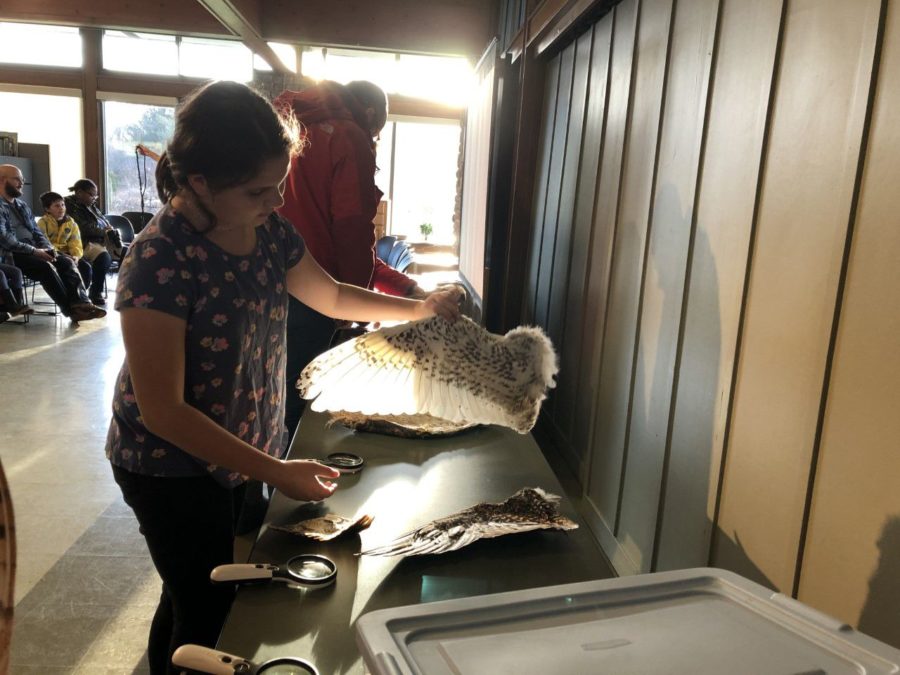A Friday night at the UK Arboretum in search of nature’s ‘perfect killing machines.’
February 6, 2020
Dr. Jim Krupa smiled at the crowd gathered at the UK Arboretum. He was ready to set the tone for the evening—a light-hearted introduction to his favorite hobby.
“Tonight is Warbler night,” he said, humorously referencing his “normal life” where he regularly spends his evenings stuffing some of the hundreds of birds preserved in his refrigerators. A biology professor at UK, Krupa’s goal is to make “steady skins” — a type of taxidermy that is less about aesthetics and more about “the science, the teaching of it.” While his in-depth knowledge of many bird species was obvious, he quickly transitioned to the main attraction of the evening: Owls.
“Each of these took between five and twelve hours” he explained, gesturing to the table of owl specimens aligned neatly for perusal by Owl Night Hike attendees. Young children, to Ph. D. students, to older couples on a date night had signed up in the hopes of glimpsing an owl in the Arboretum, and all gleaned valuable information on these “perfect killing machines” as a bonus.
It was undoubtedly the Friday night place to be.
The Owl Night Hike is hosted annually by the State Botanical Garden of Kentucky and the Central Kentucky Audubon Society (CKAS) and has, in the past, drawn upwards of 120 people to the UK Arboretum. This year’s event on Friday, January 24, had a cap of around 30, giving the hike a cozy, intimate setting.
The guides and presenters for the night were four owl enthusiasts and scholars like Dr. Krupa, people passionate about the protection and detection of Kentucky’s owls.
One woman explained to the group that she had always wanted to be a wildlife biologist, and nights like these let her feel like she was living that dream.
Tony Brusate, President of the CKAS, was the next presenter. Armed with an audio-equipped, oversized book called “The Birdsong Bible,” he instructed the group on the screeches, grunts and caws of the seven owl species which regularly come through Kentucky.
Turns out, the “hoot” belongs only to a select few owls — it was simply co-opted by Hollywood as the universal “owl sound.”
Brusate also outlined the strategy for the night. First, he would call the eastern screech owl, which makes a noise reminiscent of a horse’s whinny.
This would increase the chances of luring both an eastern screech owl and a great horned owl, the former in order to defend its territory and the latter in the hopes of devouring its smaller counterpart.
After many more owl facts and no shortage of puns, the posse set out into the gloomy, 40-degree night. Brusate led the way along the Arboretum’s winding paths, stopping at strategic locations to play the eastern screech owl calls from the speaker hung around his neck. The group fell quiet and stared intently at the tree line, illuminated by the light pollution from nearby Kroger Field and Nicholasville Rd.
“Night hikes are about bringing out your other senses,” said Brusate, before an ambulance siren broke the silence and made a few jump. Unfortunately, no owls contributed to the din.
Before long, it started to rain. This greatly decreases the chance of seeing an owl and, reluctantly, the group headed back towards the Arboretum Visitor Center.
The night had not been a waste, however. Attendees gleaned valuable information about the ecological niche of these owls and the many ecosystem benefits they provide. For instance, barn owls are being reintroduced into wineries in Kentucky in order to control the mice and reduce the use of rodenticide. Eastern screech owls keep Japanese beetle populations in check.
Kentucky owl populations, however, are threatened by lack of suitable habitat and myriad other consequences of urbanization.
When asked how the general public can help owl populations flourish, former State Naturalist Carey Tichenor highlighted small, simple actions.
“Helping out with habitat is probably the main thing,” Tichenor said. “You could make owl houses, choose not to chop down some trees or tear down that old barn… you could stop using rodenticide and pesticides, or plant certain flowers and shrubs that attract creatures the owls feed on.”
For anyone interested in future Owl Hike events or other birding outings, the CKAS website houses a well-stocked event calendar. The next owl event is an “Owl Prowl and Wine Tasting” at Talon Winery on February 16. If the Arboretum Owl Night Hike was anything to go off, it’ll be a real hoot.































































































































































